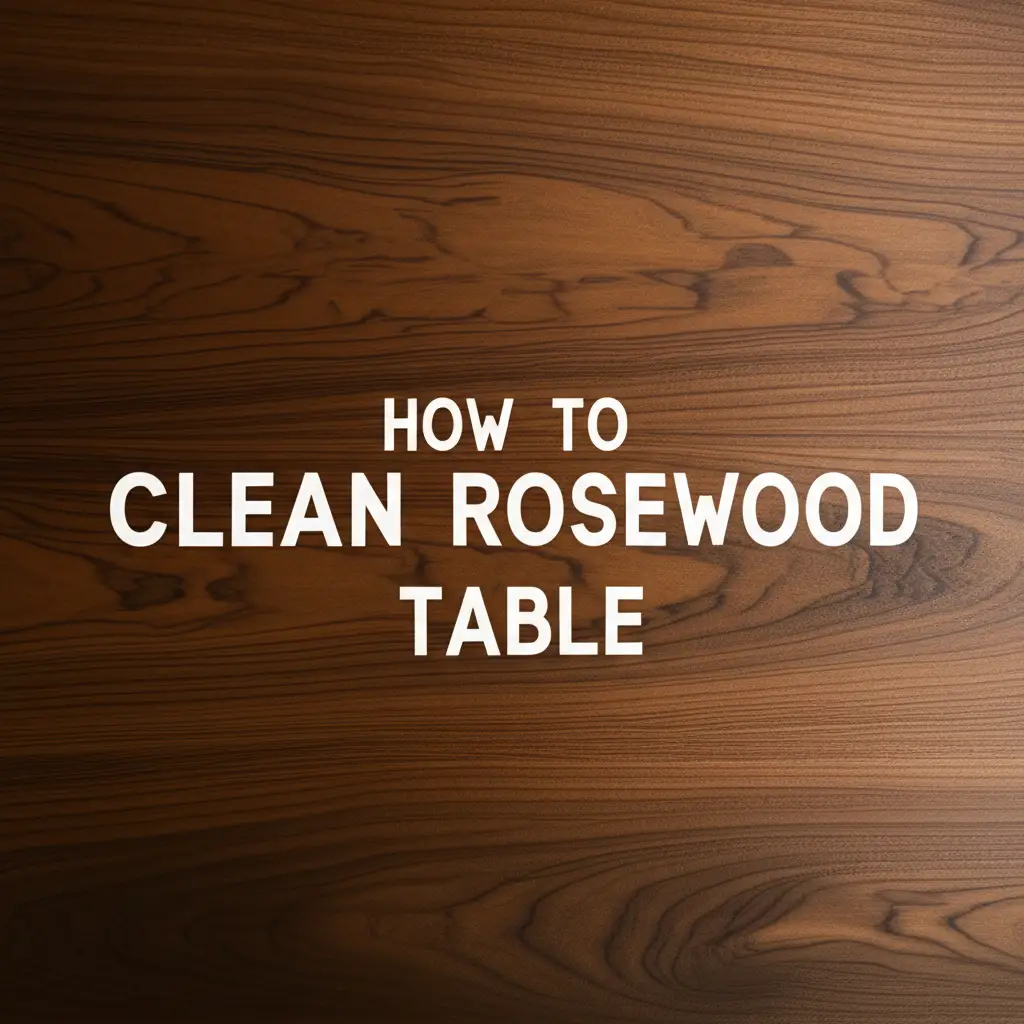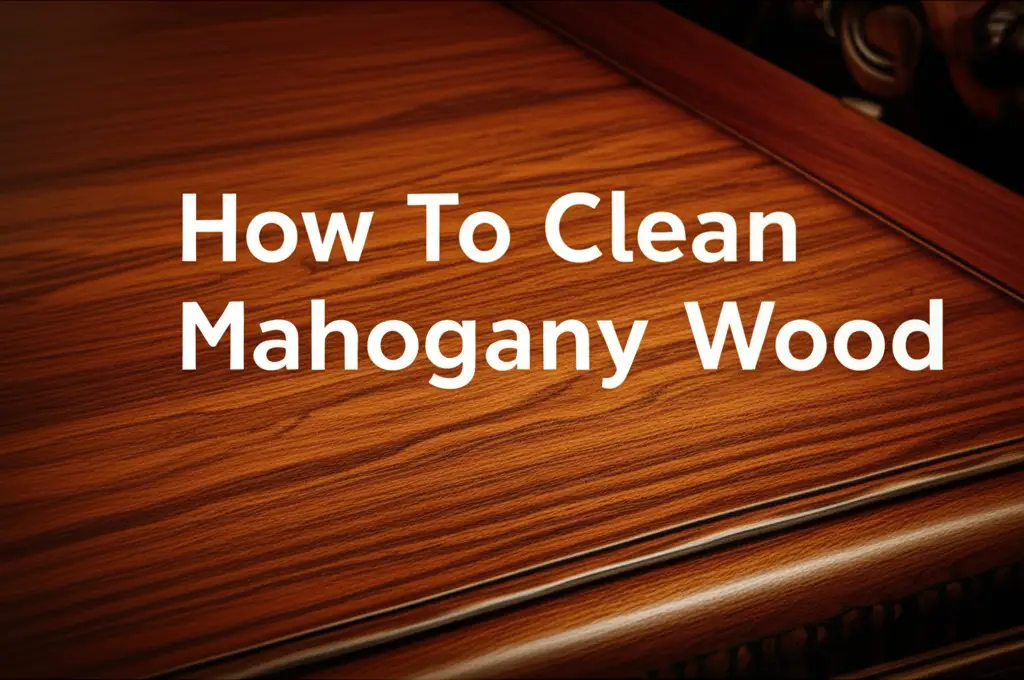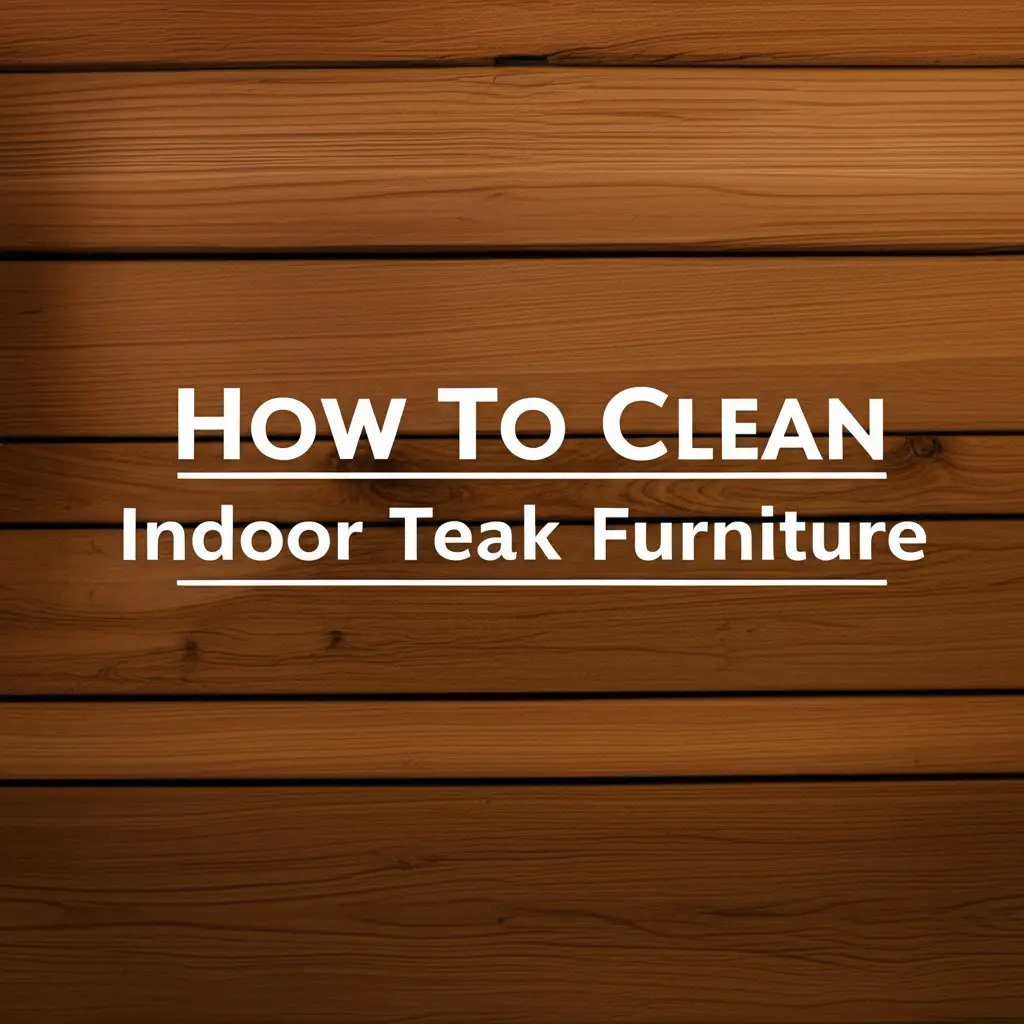· Furniture Care · 11 min read
How To Clean Rosewood Table

Unlock the Beauty: How To Clean Your Rosewood Table
Owning a rosewood table is a true joy. Its rich grain and deep color bring warmth to any room. However, maintaining its beauty requires special care. You need to know the right ways to clean rosewood without causing damage.
This guide will show you exactly how to clean a rosewood table, ensuring it stays stunning for years. We will explore daily maintenance, deep cleaning methods, and how to protect your valuable furniture. You will learn to handle common issues like dust, spills, and grime. Let’s keep your rosewood looking its best.
Takeaway
- Use soft cloths and gentle cleaners for regular dusting.
- Address spills immediately to prevent damage.
- Deep clean with specialized wood cleaners when needed.
- Protect your table from direct sunlight and heat sources.
- Apply appropriate polishes or waxes for lasting shine and protection.
How to Clean Rosewood Table
To clean a rosewood table, begin with regular dusting using a soft, dry cloth. For deeper cleaning, use a mild wood cleaner specifically designed for finished wood. Always wipe with the grain and dry the surface completely. Avoid harsh chemicals, excessive water, and abrasive materials to protect the wood’s finish and natural beauty.
Understanding Rosewood: A Guide to Its Unique Nature
Rosewood is a beautiful and dense wood. It is known for its deep, rich colors and distinct grain patterns. This wood comes from tropical trees, and its beauty makes it a popular choice for fine furniture. Because of its natural oils, rosewood has a unique luster.
This natural oil content also affects how you should clean it. Rosewood tables are often finished with lacquer, shellac, or oil. Each finish needs a slightly different cleaning approach. Knowing your table’s finish helps you pick the right cleaning method. Always test new cleaners in a hidden area first.
The wood’s hardness makes it durable. Yet, it can still scratch or fade if not cared for properly. Dust and grime can dull its surface over time. Sunlight can also cause the color to change. Proper care keeps your rosewood table looking vibrant.
Rosewood furniture is an investment. Good cleaning practices protect this investment. They help preserve its value and beauty for generations. Avoid anything that might strip its natural oils or damage its finish.
Everyday Care for Your Rosewood Table: Simple Steps
Daily cleaning helps keep your rosewood table in top condition. This simple routine prevents dust buildup and minor spills from causing damage. Regular care is much easier than tackling deep grime later. I find that a few minutes each day makes a big difference.
Start with dusting. Use a soft, lint-free cloth like microfiber. Gently wipe the entire surface. Always move with the wood grain. This removes loose dust without scratching the finish. Dusting prevents tiny particles from scratching the surface when you wipe it.
For light smudges or fingerprints, a slightly damp cloth can help. Wring out the cloth very well. It should feel almost dry. Wipe the smudges gently. Immediately follow with a dry cloth to absorb any moisture. Water can harm rosewood if left on the surface.
You should also use coasters and placemats. These protect the table from spills, heat marks, and scratches. Hot cups or cold glasses can leave rings. A simple coaster provides a barrier. This protective habit saves your table from common household accidents.
Keep your rosewood table away from direct sunlight. Strong sun rays can fade the wood’s color over time. It can also dry out the wood. Place your table in a spot with indirect light. If direct sun is unavoidable, use curtains or blinds during peak hours. Regular, gentle cleaning preserves the table’s natural beauty and protects it from daily wear.
Deep Cleaning Your Rosewood Table: Tackling Grime
Sometimes, daily dusting is not enough. Your rosewood table might accumulate grime or feel sticky over time. This calls for a deep cleaning session. A careful deep clean brings back its natural shine. It helps remove built-up dirt and residue from polishes or waxes.
For a deep clean, choose a cleaner made for finished wood. Avoid harsh chemicals, ammonia, or silicone-based products. These can strip the finish or leave a residue. I prefer gentle, pH-neutral wood cleaners. They are safe for delicate wood surfaces.
Apply a small amount of cleaner to a soft cloth. Do not spray directly onto the table. This prevents oversaturation of the wood. Wipe the table in small sections. Work with the grain to lift dirt and grime effectively. You will see the cloth pick up the dirt.
After cleaning each section, wipe it immediately with a separate clean, dry cloth. This removes any cleaner residue. It also ensures no moisture stays on the wood. Leaving moisture can cause swelling or damage to the finish. This two-step process keeps the table clean and dry.
Deep cleaning is not a daily task. I do it every few months, or when the table looks dull. It depends on how much the table is used. This process restores the wood’s natural beauty without harming its delicate surface. For general tips on how to clean other wooden furniture, you can learn more about how to clean a wooden table.
Removing Stubborn Stains from Rosewood Tables
Stubborn stains on rosewood tables can be frustrating. They can come from water rings, food spills, or ink marks. The key is to act fast and use the right method for each stain type. Different stains need different approaches to remove them safely.
For water rings, try a gentle approach first. Rubbing a small amount of petroleum jelly or mayonnaise onto the ring can help. Leave it on for several hours, then wipe it off. The oils in these products can often lift the moisture mark. This method is effective for fresh, light water rings.
Grease stains need a different touch. Sprinkle a small amount of cornstarch or talcum powder over the stain. Let it sit for a few hours or overnight. These powders absorb the oil. Brush off the powder gently with a soft cloth. Repeat if necessary until the stain is gone.
Ink stains are tougher. Dip a cotton swab in a small amount of rubbing alcohol. Lightly dab the ink stain. Do not rub, as this can spread the ink. Work from the outside of the stain inward. Immediately blot with a clean, dry cloth. This method must be used with caution. Alcohol can strip finishes if overused.
For tough or unknown stains, it is best to consult a professional. They have specialized tools and knowledge. Attempting to remove certain stains incorrectly can cause permanent damage. Always test any stain removal method in an inconspicuous area first. If you need more specific guidance on tough wood stains, check out tips on how to clean stains on wood.
Polishing and Protecting Your Rosewood Table
After cleaning, polishing and protecting your rosewood table is crucial. This step enhances its natural luster and creates a barrier against future damage. Polishing brings out the deep colors and beautiful grain. Protection helps your table withstand daily use.
Choose a polish specifically for fine wood. Wax-based polishes or natural oil polishes are often good choices for rosewood. Avoid silicone-based sprays, as they can build up over time. They can also leave a sticky residue. Natural products allow the wood to breathe.
Apply the polish sparingly with a clean, soft cloth. Work in small sections, following the wood grain. Use gentle, circular motions to spread the polish evenly. A little goes a long way. Too much polish can make the surface greasy or streaky.
Allow the polish to sit for a few minutes, as directed by the product. Then, buff the surface with a separate, clean, dry cloth. Buff until the table shines. This removes excess polish and brings out the luster. Regular polishing revitalizes the wood.
Protect your table from direct heat and moisture. Use trivets under hot dishes and coasters under drinks. Consider a table pad for everyday use if your table sees heavy activity. This layer of protection guards against scratches and spills. These steps keep your rosewood table looking its best for many years.
Restoring Minor Damage: Scratches and Fading
Even with the best care, rosewood tables can get minor damage. Small scratches, nicks, or areas of fading can happen. Addressing these issues early helps prevent them from getting worse. You can often fix minor flaws yourself with simple tools.
For light scratches, you can try a wood scratch repair kit. These kits often contain wax crayons or markers in different wood tones. Find a color that matches your rosewood. Carefully fill the scratch with the crayon. Then, gently buff it with a soft cloth. This helps blend the scratch into the surrounding wood.
For deeper scratches, a wood filler might be needed. Choose a filler that matches rosewood or can be stained to match. Apply a tiny amount of filler into the scratch. Use a putty knife to smooth it level with the surface. Let it dry completely. You may need to lightly sand it with very fine-grit sandpaper, then re-finish the small area.
Fading due to sunlight is harder to fix. If the fading is minor, re-oiling or re-polishing the table can help even out the color. For significant fading, professional refinishing might be the best option. They can strip the old finish and apply a new one. This restores the wood’s original deep color.
Always test any repair product in an unseen area first. This ensures it matches the color and does not harm the finish. Patience is key when restoring wood. Taking your time leads to better results. Proper care helps minimize future damage.
Common Mistakes to Avoid When Cleaning Rosewood
Cleaning rosewood correctly requires avoiding common errors. Some actions can cause more harm than good. Knowing these mistakes helps you protect your valuable furniture. I have learned these lessons through experience.
First, never use harsh chemical cleaners. Products containing ammonia, silicone, or abrasive particles are damaging. They can strip the natural oils and finish. This leaves the wood dry, dull, or even discolored. Stick to cleaners made for fine wood furniture.
Second, avoid too much water. Rosewood is sensitive to moisture. Leaving water on the surface can cause water rings, swelling, or even mold. Always wring out cloths very well. Dry the table immediately after wiping. Moisture is a big enemy of wood.
Third, do not use abrasive materials. Steel wool, rough sponges, or harsh scrubbers will scratch the delicate finish. Always use soft microfiber cloths or cotton rags. Gentle handling is vital for preserving the wood’s surface.
Fourth, skipping regular dusting is a mistake. Dust contains tiny particles that are abrasive. When you wipe a dusty surface, these particles can cause micro-scratches. Regular, gentle dusting prevents this buildup. It keeps the table smoother.
Finally, do not place hot or cold items directly on the table. This leads to unsightly water rings or heat marks. Always use coasters, trivets, or placemats. This simple act of protection prevents permanent damage. Avoiding these common mistakes keeps your rosewood table beautiful.
FAQ Section
Can I use water to clean rosewood?
You should use water sparingly to clean rosewood. A damp cloth, wrung out very well, can remove light smudges. Always follow immediately with a dry cloth to absorb all moisture. Excess water can damage the wood and its finish, leading to swelling or water marks.
How often should I clean my rosewood table?
Dust your rosewood table several times a week, or daily if it sees heavy use. Deep cleaning with a wood cleaner is usually needed every few months, or when the table appears dull or sticky. This schedule keeps it looking fresh without over-cleaning.
What products should I avoid on rosewood?
Avoid harsh chemical cleaners, ammonia-based products, silicone sprays, and abrasive cleaners. Do not use furniture polishes that contain wax buildup or petroleum distillates not meant for fine wood. These products can strip the finish, dry out the wood, or leave damaging residues.
Can I polish rosewood with olive oil?
It is not recommended to polish rosewood with olive oil. While natural oils can seem appealing, food oils like olive oil can turn rancid over time. This leaves a sticky, unpleasant residue on your table. Stick to specialized wood polishes or waxes designed for furniture.
How do I remove water rings from rosewood?
For fresh water rings, you can gently rub a small amount of petroleum jelly or mayonnaise over the mark. Let it sit for several hours, then wipe clean. For older or stubborn rings, specialized wood ring removers might be necessary. Always test in a hidden area first.
Is rosewood durable for daily use?
Rosewood is a very dense and durable wood, making it suitable for daily use. However, its finish can be delicate. It is important to protect the surface from scratches, heat, and moisture with coasters, placemats, and regular, gentle cleaning to maintain its beauty over time.
Conclusion
Cleaning your rosewood table does not have to be difficult. By understanding its unique properties and following simple, consistent steps, you can keep this valuable piece of furniture looking its best. Regular care extends its life and preserves its beauty for future generations.
Remember, gentle dusting, careful deep cleaning, and immediate attention to spills are key. Use the right products and avoid harsh chemicals or excessive moisture. Your rosewood table is a cherished item, and with proper cleaning, it will continue to be a stunning centerpiece in your home. Take the time to care for it. You will enjoy its rich glow for many years.
- rosewood cleaning
- rosewood care
- wood furniture care
- antique rosewood
- table maintenance




